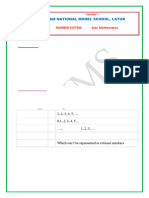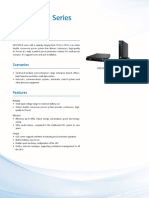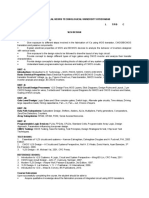Math-7-Q1-Week-8
Math-7-Q1-Week-8
Uploaded by
pagalilauanjonelCopyright:
Available Formats
Math-7-Q1-Week-8
Math-7-Q1-Week-8
Uploaded by
pagalilauanjonelCopyright
Available Formats
Share this document
Did you find this document useful?
Is this content inappropriate?
Copyright:
Available Formats
Math-7-Q1-Week-8
Math-7-Q1-Week-8
Uploaded by
pagalilauanjonelCopyright:
Available Formats
MATH 7 QUARTER 1 Week 8
Competency
The learner illustrates the different subsets of real numbers (M7NS – lh – 1), arranges
real numbers in increasing or decreasing order and on the number line.
Expectations
This module is designed to help you understand the real number system. After going
through this module, you are expected to:
1. Define real numbers and its subsets;
2. Identify to which subset a given number belongs;
3. Arrange real numbers in increasing or decreasing order;
4. Compare real numbers; and
5. Locate the real numbers on the number line.
Pre-test
Read each item carefully. Write the letter of the best answer.
1. Which of the following is an irrational number?
A. -10 B. -√9 C. √17 D. 5.499
2. Each of the following belongs to the set of rational numbers, except:
A. -√25 B. - 2.33333… C. 2.14 D. √8
1
3. Which is true about 3 and √3?
1 1
A. 3 is less than √3 C. 3 is equal to √3
1 1
B. √3 is less than D. 3 and √3 are both greater than 3
3
2 3
4. In the numbers 3, 0.25, 4, and √5, which should be placed first if these numbers are arranged in
ascending order?
D. √5
2 3
A. B. 0.25 C.
3 4
MATH 7 QUARTER 1 WEEK 8 P a g e 1 | 10
5. Which of the following shows the location of √24 on the number line?
A. C.
B. D.
Looking Back at Your Lesson
The numbers you encountered in the past modules are all real numbers – the rational and the
irrational numbers. You have learned how to deal with integers, fractions, decimals, and square roots.
Although numbers can be written in different forms, these can all be converted into decimals.
Fractions can be written in decimal forms by dividing the numerator by the denominator.
Examples:
9 1 3
1. Convert 5 to a decimal. 2. Convert 3 to a decimal. 3. Convert 8 to a decimal.
Answer: 1.8
Answer: 0.333… or 0.3̅ Answer: 0.375
The square roots of perfect squares are whole numbers. However, the square roots of non-
perfect squares are irrational. You have learned how to estimate the square root of a number and plot
in a number line.
Examples:
1. √27 27 is in between the perfect squares 25 and 36.
So √27 lies in between 5 and 6.
Also, 27 is closer to 25 than to 36, so it should be closer to 5 than to 6
when plotted on a number line.
√27
2. √98 98 is in between the perfect squares 81 and 100.
So √98 lies in between 9 and 10.
Also, 98 is closer to 100 than to 81, so it should be closer to 10 than to 9
when plotted on a number line.
ඥ98
MATH 7 QUARTER 1 WEEK 8 P a g e 2 | 10
Introduction of the Topic
Lesson 1: Subsets of Real Numbers
Almost all the numbers you encountered in your previous lessons and in your elementary days
are REAL NUMBERS. The set of real numbers are divided into two subsets, the set of rational
numbers (ℚ) and the set of irrational numbers (ℚ′). The set of all rational numbers include the set
of integers (ℤ), the set of whole numbers (W), and the set of natural numbers (ℕ).
The illustration below shows the relationship between the subsets of real numbers.
The Real Number System
1. The set of Natural Numbers/ Counting Numbers (ℕ) is {1, 2, 3, 4, 5, …}. These are the
numbers you use when counting things. It starts with 1 and continues indefinitely.
2. The set of Whole Numbers (𝕎) is composed of the set of natural numbers and the zero, i.e.
{0, 1, 2, 3, 4, …}.
3. The set of Integers (ℤ) include the negative integers, the zero, and the positive integers, i.e.
{…, -5, -4, -3, -2, -1, 0, 1, 2, 3, 4, 5, …}.
4. The set of Rational Numbers (ℚ) is composed of those that can be expressed as a quotient of
a
two integers, b, where a and b are integers and b ≠0. The rational numbers can be in a fraction
form or in a decimal form. Rational numbers in decimal forms are terminating decimals or non-
terminating repeating decimals. It is important to highlight as well that natural/counting numbers,
a
whole numbers, and integers are all rational numbers since they can be written in the form ,
b
with 1 as the denominator.
2 5 5 ̅̅̅̅, 0.3̅
Examples: -10, -2, 0, 5, 7, 3 , 4 , 1 7 , 0.5, 0.44, √9, 0.09
MATH 7 QUARTER 1 WEEK 8 P a g e 3 | 10
5. The set of Irrational Numbers (ℚ′) consists of those that cannot be written as a quotient of two
integers. All irrational numbers can be in the form of decimals which are non-terminating and
non-repeating.
Examples: π (read as "pi", 3.1415926…), e (Euler' s number, 2.718281…), √2 (1.414213…),
1. 732050807568…
More Examples of Real Numbers
As you can observe from the diagram above, Real Numbers are composed of Rational
and Irrational Numbers. Inside the rational numbers, you can see the smaller subsets such as
the Integers (positive integers, zero and negative integers), Whole Numbers (natural numbers
and zero) and the Natural or Counting Numbers (starts with 1 to positive infinity).
All natural numbers are whole numbers. All whole numbers are integers. All integers are
rational numbers. All rational numbers are real numbers. All numbers which are not rational are
called irrational numbers. All irrational numbers are also real numbers. All these numbers make
up the real number system.
Activity 1.1: Check Me Out
Classify each real number as a natural number (ℕ), a whole number (𝕎), an integer (ℤ), a
rational number (ℚ), or an irrational number (ℚ′). Put a check mark (✓) to all possible answers.
ℕ 𝕎 ℤ ℚ ℚ′ ℕ 𝕎 ℤ ℚ ℚ′
9 3
1. 8.
10 4
2. -18 9. 2.53
3. 125 10. 14
4. -6 11. √7
MATH 7 QUARTER 1 WEEK 8 P a g e 4 | 10
5. ඥ15 12. ̅̅̅̅
2.73434
6. 15 13. 0
9
7. 2 14. π
100
Activity 1.2: Which Number Am I?
Read each item carefully. Choose from the numbers below what is being described in each item.
1
1
2
-15 √10
̅̅̅̅
0.27 3
1. I am an integer, a whole number, and a natural number. Which number am I? _____
2. I look something different, but I am a real number. I cannot be expressed as a fraction, but I
can be in a decimal form. Which number am I? _____
3. I am a number you can use when you want to tell what portion you need, how much
ingredients to use, or how much time you spent. I am a rational number, but I am not an
integer. Which number am I? _____
4. I am a number you can use to describe a bone-chilling temperature. I am an integer but not a
whole number. Which number am I? _____
5. I am a number with overline that signals I am repeating. I can be written in fraction form, so I
am a rational number. Which number am I? _____
Lesson 2: Arranging, Comparing and Locating Real Numbers
Real numbers can be listed in order even if they are written in different forms. When necessary,
you can convert all the real numbers into decimals to easily arrange, compare or locate them. The
number line is useful in this lesson. A number line is a horizontal line that has two arrowheads which
means that it extends indefinitely in both directions. Zero is the point of origin. All numbers to the left
of zero are negative numbers while to the right of zero are the positive numbers.
• The numbers increase from left to right.
• The number on the left is always less than the number on the right.
• Positive numbers are always greater than any negative number.
MATH 7 QUARTER 1 WEEK 8 P a g e 5 | 10
Observe the figure below.
Given the illustration above, you can easily arrange the numbers in increasing order (list the
numbers on the number line from left to right) and decreasing order (list the numbers on the number
line from right to left) and even compare its values. How about if the numbers are not plotted on a
number line? How would you know which of them has the greatest or the lowest value?
For non-integers, you need to get the decimal form first before you can easily compare the
values. Here are the respective decimal forms or approximate values to the nearest hundredths:
8 7
– √45 ≈ –6.71 – = – 1.60 ඥ30 ≈ 5.48 – ඥ10 ≈ –3.16 = 3.50 ඥ92 ≈ 9.59
5 2
Activity 2.1: Count and Compare
Write the correct symbol for each of the following pairs of real numbers. Choose from the symbols
<, >, or =.
8 7
Examples: – √45 < -6 – 5 > – √10 2
= 3.5
1) –3 ___ 5 3) –7.8 ___ 7. 8 5) 𝜋 ___ 3 7) √40 ___ 4
1 9 1 ̅̅̅̅ ___ 32
2) 0.25 ___ 4 4) ___ √2 6) ___ 0.333333… 8) 3.27
5 3 7
Activity 2.2: Follow My Order
Arrange each of the following sets of numbers from least to greatest (increasing order).
1
1) 12, –3 , 5, –2, –8 4) – 6 , –6, 6, 1, 0
2) –4, 6, –7, 0, 7 5) √50, 5, -8, -9, 10
1 3 9
3) –0.33, 2, 4, 𝜋, 4
MATH 7 QUARTER 1 WEEK 8 P a g e 6 | 10
Activity 2.3: Fall in Line
5 1
1) Locate the numbers - ,4, -3, 2 , and √65 on the number line.
3 4
1 13 9
2) Locate the following numbers on the number line: , -√9, , - , √95.
4 3 2
Remember
➢ The set of real numbers (ℝ) consists of all the rational and irrational numbers.
➢ The set of natural numbers/ counting numbers (ℕ) is {1, 2, 3, 4, 5, …}.
➢ The set of whole numbers (𝕎) is composed of the set of natural numbers and the zero,
i.e. {0, 1, 2, 3, 4, …}.
➢ The set of integers (ℤ) include the negative integers, the zero, and the positive integers,
i.e. {…, -5, -4, -3, -2, -1, 0, 1, 2, 3, 4, 5, …}.
➢ The set of rational numbers (ℚ) is composed of those that can be expressed as a quotient
a
of two integers, b, where a and b are integers and b ≠0. The rational numbers can be in
a fraction form or in a decimal form. Rational numbers in decimal forms are terminating
decimals or non-terminating repeating decimals.
➢ The set of irrational numbers (ℚ′) consists of those that cannot be written as a quotient of
two integers. All irrational numbers can be in the form of decimals which are non-
terminating and non-repeating.
➢ Real numbers can easily be arranged if you convert first the non-integers into decimals.
➢ In a number line, the numbers increase from left to right. Positive numbers are always
greater than any negative number. The number on the left is always less than the number
on the right.
MATH 7 QUARTER 1 WEEK 8 P a g e 7 | 10
Check Your Understanding
A. Classify each real number as a natural number (ℕ), a whole number (𝕎), an integer (ℤ), a rational
number (ℚ), or an irrational number (ℚ′). Put a check mark (✓) to all possible answers.
ℕ 𝕎 ℤ ℚ ℚ′ ℕ 𝕎 ℤ ℚ ℚ′
3
1. 9 6. 54
2. -30 7. -9.25
11
3. 𝜋 8.
100
4. √11 9. -1
5. 0.75 10. ̅̅̅̅
0.3181
B. Tell whether the statement is True or False.
________1. Zero is an integer.
________2. All integers are rational numbers.
________3. Rational numbers are real numbers.
________4. Natural numbers are whole numbers.
________5. Some irrational numbers are integers.
________6. All irrational numbers are real numbers.
________7. All whole numbers are natural numbers.
________8. All rational numbers are whole numbers.
________9. Negative integers are irrational numbers.
________10. Irrational numbers can be written in fraction forms.
C. Write the correct symbol for each of the following pairs of real numbers. Choose from the
symbols <, >, or =.
100 6
1) _____ 2 3) 0.5 _____ 5 5) 19 _____ √99
50
1 3
2) -13 _____ 5 4) -67 _____ √64 6) _____
6 8
D. Arrange each set of real numbers in increasing order.
10 18 27 36
1) 5, 4, 1, -2 2) , , , 3) -√3, √2, √1, √4
2 4 3 9
MATH 7 QUARTER 1 WEEK 8 P a g e 8 | 10
7
E. Locate the following numbers on the number line: -6.5, 1.25, , 2√6.
2
Post-test
Read each item carefully. Write the letter of the best answer.
1. Which of the following is an irrational number?
A. -10 B. -√9 C. √17 D. 5.499
2. Each of the following belongs to the set of rational numbers, except:
A. -√25 B. - 2.33333… C. 2.14 D. √8
1
3. Which is true about 3 and √3?
1 1
A. 3 is less than √3 C. 3 is equal to √3
1 1
B. √3 is less than D. 3 and √3 are both greater than 3
3
2 3
4. In the numbers 3, 0.25, 4, and √5, which should be placed first if these numbers are arranged in
ascending order?
2 3
A. 3 B. 0.25 C. 4 D. √5
5. Which of the following shows the location of √24 on the number line?
A. C.
B. D.
MATH 7 QUARTER 1 WEEK 8 P a g e 9 | 10
MATHEMATICS 7
Quarter 1 Week 8
ANSWER SHEET
Name: Math Teacher:
Section: Score:
MATH 7 QUARTER 1 WEEK 8 P a g e 10 | 10
You might also like
- GRADE 9 - Maths - Trace The Concept - Teacher DocumentDocument101 pagesGRADE 9 - Maths - Trace The Concept - Teacher DocumentmariahcopisoNo ratings yet
- 25-60-95 Rev12Document232 pages25-60-95 Rev12jose.sierrasanchisNo ratings yet
- Stress-Free Math: A Visual Guide to Acing Math in Grades 4-9From EverandStress-Free Math: A Visual Guide to Acing Math in Grades 4-9No ratings yet
- Empowerment Q4 Module1Document9 pagesEmpowerment Q4 Module1Lovely Iñigo100% (6)
- Math7 Q1 SLM WK7Document11 pagesMath7 Q1 SLM WK7RheaMaeDeLeonAntiguaNo ratings yet
- 8.1 Real Number LineDocument6 pages8.1 Real Number LineAlex2345660No ratings yet
- Module 6 7Document6 pagesModule 6 7Felix Jones BanaresNo ratings yet
- Unit 1Document26 pagesUnit 1Roxane EsguerraNo ratings yet
- QA Master - 4840647 - 2024 - 03 - 27 - 12 - 07Document118 pagesQA Master - 4840647 - 2024 - 03 - 27 - 12 - 07sohan.ghosh23-25No ratings yet
- Summary of all the course content _2244cc0344c12cb_250102_183925Document79 pagesSummary of all the course content _2244cc0344c12cb_250102_183925ibereayomioNo ratings yet
- Class 9 - Chapter 1 - Number SystemDocument22 pagesClass 9 - Chapter 1 - Number SystemLKNo ratings yet
- 1720808211numbers LCM Ebook01Document30 pages1720808211numbers LCM Ebook01sattwikd77No ratings yet
- Student EditionDocument52 pagesStudent Editionapi-264460698No ratings yet
- Number System Class 9Document17 pagesNumber System Class 9gaurav nangru100% (1)
- Math Chapter 1Document38 pagesMath Chapter 1Abu Huzaifah100% (1)
- Theory of NumbersDocument106 pagesTheory of NumberspreetyNo ratings yet
- Mathematics: Class 9th (KPK)Document21 pagesMathematics: Class 9th (KPK)Technical CrackerNo ratings yet
- Mathematics: Class 9th (KPK)Document21 pagesMathematics: Class 9th (KPK)Manan BangashNo ratings yet
- Math7 q1 m1 Principal Root and Irrational Numbers v1Document6 pagesMath7 q1 m1 Principal Root and Irrational Numbers v1Edward Lorenz TabligaNo ratings yet
- Math 7 GRADE 7 DAY ONLYDocument9 pagesMath 7 GRADE 7 DAY ONLYERRALYN PEÑAFLORIDANo ratings yet
- Handout w01Document8 pagesHandout w01Ghifary ArrasyidNo ratings yet
- Mathematics For Senior Phase Booklet Grades 7 9Document126 pagesMathematics For Senior Phase Booklet Grades 7 9bridgetlaishiNo ratings yet
- Math 7 Week 3 Q1Document15 pagesMath 7 Week 3 Q1Carl Joshua Francisco100% (1)
- Number SystemDocument31 pagesNumber Systemanujsandikar2009No ratings yet
- Number System: Must-Know Cat Tips & TricksDocument44 pagesNumber System: Must-Know Cat Tips & TricksdeepamjyotiroutrayNo ratings yet
- Chapter 1 RealnumberDocument21 pagesChapter 1 RealnumberjamaludinizzadNo ratings yet
- Skripta Inf - Mat - Fiz - TehDocument99 pagesSkripta Inf - Mat - Fiz - TehpaulaNo ratings yet
- Syllabus VII 2024-25Document10 pagesSyllabus VII 2024-25Mehreen RathoreNo ratings yet
- Math 7-ADM-Module 8 - Final - v2 - Reviewed - EditedDocument29 pagesMath 7-ADM-Module 8 - Final - v2 - Reviewed - Editedjussan roaringNo ratings yet
- Skripta Inf - Mat - Fiz - TehDocument99 pagesSkripta Inf - Mat - Fiz - TehPaola KrpanNo ratings yet
- Mathematics for the Senior Phase Grades 7 to 9Document126 pagesMathematics for the Senior Phase Grades 7 to 9sadya98No ratings yet
- Math 9 - Q1 - WK 2 - Module 2 - The Nature Sum and Product of The Roots of Quadratic EquationDocument20 pagesMath 9 - Q1 - WK 2 - Module 2 - The Nature Sum and Product of The Roots of Quadratic EquationTerrence RicafrancaNo ratings yet
- Project WorkDocument47 pagesProject WorkVaibhav bhandariNo ratings yet
- Apptitude 5Document20 pagesApptitude 5Ejigayehu TesfayeNo ratings yet
- Prime NumberDocument8 pagesPrime NumbertriptiagNo ratings yet
- Math G9 Class Notes (3) Part ADocument12 pagesMath G9 Class Notes (3) Part AJialin wangNo ratings yet
- Number System - 1Document6 pagesNumber System - 1ms veluNo ratings yet
- NCERT Solutions For Cbse Class 9 Maths Chapter 1 Number System PDFDocument22 pagesNCERT Solutions For Cbse Class 9 Maths Chapter 1 Number System PDFAvinash KumarNo ratings yet
- Real NumbersDocument9 pagesReal Numbersmayaanb155No ratings yet
- IBA BBA Math Lecture 01Document11 pagesIBA BBA Math Lecture 01abir157shantoNo ratings yet
- BasicsZEALBooklet FDocument22 pagesBasicsZEALBooklet Froyprakhar95No ratings yet
- SUBSET of Real NumbersDocument20 pagesSUBSET of Real Numbersshermaine.tabierosNo ratings yet
- 16625448821644056111number SystemDocument16 pages16625448821644056111number System1202vishvanandNo ratings yet
- Teachers Learning Plan in Grade 7 Mathematics: Pagadian Diocesan Schools Saint Andrew's Academy of San Pablo, IncDocument3 pagesTeachers Learning Plan in Grade 7 Mathematics: Pagadian Diocesan Schools Saint Andrew's Academy of San Pablo, IncA Lo NaNo ratings yet
- Chapter 1Document6 pagesChapter 1NIHAL SAINo ratings yet
- August 26 2020 - MAT1033-Fall 2020 - Chapter 1.2Document16 pagesAugust 26 2020 - MAT1033-Fall 2020 - Chapter 1.2greg lucasNo ratings yet
- Gr 9 Whole numbersDocument56 pagesGr 9 Whole numbersTruddy MtsweniNo ratings yet
- Tech Maths GR 10 Relab Term 1 - 4 Learner Guide - 08 - 240603 - 073955Document165 pagesTech Maths GR 10 Relab Term 1 - 4 Learner Guide - 08 - 240603 - 073955mchwizanamasabzNo ratings yet
- Principal Root of A NumberDocument14 pagesPrincipal Root of A NumberRowena Lalongisip De LeonNo ratings yet
- Class 10 Maths Chapterwise Topicwise Notes Chapter 1 Real NumbersDocument103 pagesClass 10 Maths Chapterwise Topicwise Notes Chapter 1 Real Numberssmita1980pbhNo ratings yet
- Unit 1 SetsDocument12 pagesUnit 1 SetsDeneika MorganNo ratings yet
- Cambridge Lower Secondary Mathematics Progression Grid Tcm143-592637Document61 pagesCambridge Lower Secondary Mathematics Progression Grid Tcm143-592637Adonai David RaharjoNo ratings yet
- Classification of Numbers: Real Numbers Complex NumbersDocument20 pagesClassification of Numbers: Real Numbers Complex NumbersTarun Arora100% (1)
- G7 Math Q1 W7 Oc-1 PDFDocument10 pagesG7 Math Q1 W7 Oc-1 PDFConisa Abdul AzisNo ratings yet
- Solved Problems in Algebra PDFDocument66 pagesSolved Problems in Algebra PDFJoshua Casuga100% (1)
- 6ADocument4 pages6AofyobusnesnonaNo ratings yet
- Class IX Maths IITFoundation & Olympiad Study Package (PDFDrive)Document216 pagesClass IX Maths IITFoundation & Olympiad Study Package (PDFDrive)Vinayak GuptaNo ratings yet
- G7 Math Binder Vol 1 PDFDocument133 pagesG7 Math Binder Vol 1 PDFDhriti GuptaNo ratings yet
- G. BABAGAY Module 1st QTRDocument11 pagesG. BABAGAY Module 1st QTRGianne BabagayNo ratings yet
- CH 2Document21 pagesCH 2api-3761826No ratings yet
- 0862 LowerSecondary Mathematics ProgressionGrid Tcm143-592637Document61 pages0862 LowerSecondary Mathematics ProgressionGrid Tcm143-592637meet.palawatNo ratings yet
- Welcome To Grade-9Math PrepDocument113 pagesWelcome To Grade-9Math Preparhaanie09No ratings yet
- UPS2000-G Series (1-3kVA) DatasheetDocument2 pagesUPS2000-G Series (1-3kVA) DatasheetfishNo ratings yet
- MX 8000Document307 pagesMX 8000GyannkNo ratings yet
- ECG Denoising Using Wiener Filter and Kalman FilterDocument9 pagesECG Denoising Using Wiener Filter and Kalman FilterChen DavidNo ratings yet
- CCC Vmware Server Installation Guide: Document Version 1.0-02.00.1 Build 016Document16 pagesCCC Vmware Server Installation Guide: Document Version 1.0-02.00.1 Build 016raddouaneNo ratings yet
- Is.7938.1976-Air ReceiversDocument11 pagesIs.7938.1976-Air ReceiversRAJESHNo ratings yet
- DELMIA Robotics 2 (WL2) : CSM Object Modeler (CSM)Document23 pagesDELMIA Robotics 2 (WL2) : CSM Object Modeler (CSM)kiran babuNo ratings yet
- ARCELOR Piling HandbookDocument361 pagesARCELOR Piling Handbookjuanan69100% (6)
- I9060 Electrical Part List PDFDocument5 pagesI9060 Electrical Part List PDFDaniel CekulNo ratings yet
- Trusting BrainsDocument11 pagesTrusting BrainsDell pc My computerNo ratings yet
- SERVOPRO MultiExact 4100 BrochureDocument4 pagesSERVOPRO MultiExact 4100 BrochurekollmannNo ratings yet
- GSE SCALE 350 Manual PDFDocument34 pagesGSE SCALE 350 Manual PDFSergio HernandezNo ratings yet
- B14. UG - CAO.00132 Tools & EquipmentDocument39 pagesB14. UG - CAO.00132 Tools & EquipmentAxel DoñanNo ratings yet
- Blackburn Skua (Mkii) and Roc: A Guide For Panel Lines, Access Panels and Errors in Published PlansDocument18 pagesBlackburn Skua (Mkii) and Roc: A Guide For Panel Lines, Access Panels and Errors in Published Planspatrick690703100% (1)
- CSS - 06-Module 6.2 - Windows ServerDocument10 pagesCSS - 06-Module 6.2 - Windows ServerMorelei FernandezNo ratings yet
- Samsung: and Product Line Product Width and Product DepthDocument9 pagesSamsung: and Product Line Product Width and Product DepthShivani PanchalNo ratings yet
- Atmel 8051 Microcontroller Family - Product Selection GuideDocument26 pagesAtmel 8051 Microcontroller Family - Product Selection GuideSo Was RedNo ratings yet
- State of The Ecosystem For Youth Entrepreneurship in Bangladesh 2021Document142 pagesState of The Ecosystem For Youth Entrepreneurship in Bangladesh 2021Muhammad AzeemNo ratings yet
- NCM 113 Rle Journal ReadingDocument4 pagesNCM 113 Rle Journal ReadingBrandy JaffarNo ratings yet
- Cylinder Head Instalation Procedures (Converted)Document9 pagesCylinder Head Instalation Procedures (Converted)Nasser AyoubNo ratings yet
- Medieval AgesDocument1 pageMedieval AgesLei Ann CusiNo ratings yet
- VE TI L2 Tests ProgressTest1Document3 pagesVE TI L2 Tests ProgressTest1Anna WilkNo ratings yet
- Vlsi DesignDocument2 pagesVlsi DesignShribala NagulNo ratings yet
- Hydraulic SealsDocument65 pagesHydraulic SealsM Ramzi100% (3)
- TAS DOPO DatasheetDocument4 pagesTAS DOPO DatasheetTushar PusadkarNo ratings yet
- Elektor Electronics 2020-07 08 USADocument116 pagesElektor Electronics 2020-07 08 USAPaulo Chachamovich100% (1)
- John Benson SonyDocument2 pagesJohn Benson SonyLê Hồng NhungNo ratings yet
- Hacker Magazine 1 Have A Good Read .Document66 pagesHacker Magazine 1 Have A Good Read .0dev cryptoNo ratings yet
- Engineering Mathematics With MATLAB 1st Edition Won Y. Yang All Chapters Instant DownloadDocument62 pagesEngineering Mathematics With MATLAB 1st Edition Won Y. Yang All Chapters Instant Downloadkatrebmaylo100% (3)

























































































